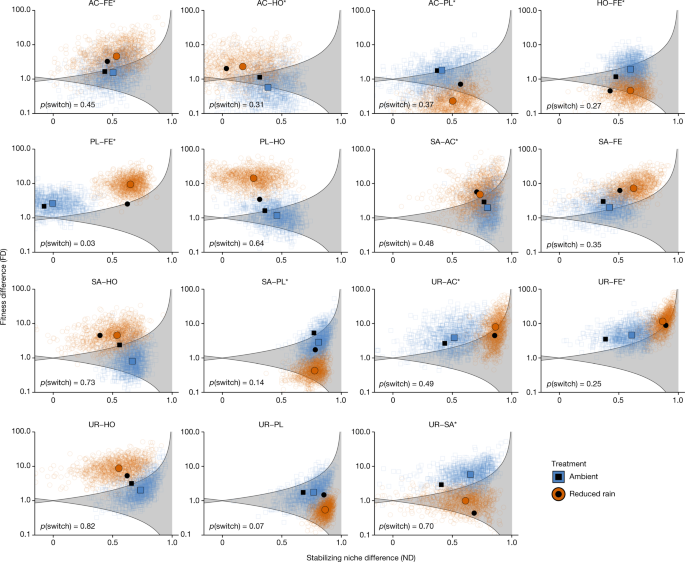Play all audios:
Access through your institution Buy or subscribe arising from: M. N. Van Dyke et al. _Nature_ https://doi.org/10.1038/s41586-022-05391-9 (2022). A 2022 study by Van Dyke et al.1 paired
experimental drought manipulations with demographic models and trait data to project major shifts in coexistence among a number of annual plant taxa. A reanalysis of these data that includes
comparisons of alternative competition models reveals that the authors’ original conclusions are strongly sensitive to model choice. Furthermore, propagating error in model parameters into
coexistence predictions results in relatively weak support for the majority of coexistence shifts that were predicted by the authors’ original model. These results suggest that there is a
need for increased statistical rigour when treating binary predictions of species coexistence as observed experimental outcomes. This is a preview of subscription content, access via your
institution ACCESS OPTIONS Access through your institution Access Nature and 54 other Nature Portfolio journals Get Nature+, our best-value online-access subscription $29.99 / 30 days cancel
any time Learn more Subscribe to this journal Receive 51 print issues and online access $199.00 per year only $3.90 per issue Learn more Buy this article * Purchase on SpringerLink *
Instant access to full article PDF Buy now Prices may be subject to local taxes which are calculated during checkout ADDITIONAL ACCESS OPTIONS: * Log in * Learn about institutional
subscriptions * Read our FAQs * Contact customer support CODE AVAILABILITY Code to replicate this analysis is available at https://doi.org/10.5281/zenodo.7460881 REFERENCES * Van Dyke, M.
N., Levine, J. M. & Kraft, N. J. B. Small rainfall changes drive substantial changes in plant coexistence. _Nature_ 611, 501–511 (2022). Google Scholar * Matías, L., Godoy, O.,
Gómez-Aparicio, L. & Pérez-Ramos, I. M. An experimental extreme drought reduces the likelihood of species to coexist despite increasing intransitivity in competitive networks. _J. Ecol._
106, 826–837 (2018). Article Google Scholar * Díaz, S. & Cabido, M. Vive la différence: plant functional diversity matters to ecosystem processes. _Trends Ecol. Evol._ 16, 646–655
(2001). Article Google Scholar * Chesson, P. in _Ecological Systems: Selected Entries from the Encyclopedia of Sustainability Science and Technology_ (ed. Leemans, R.) 223–256 (Springer,
2013). * Law, R. & Watkinson, A. R. Response-surface analysis of two-species competition: an experiment on _Phleum arenarium_ and _Vulpia fasciculata_. _J. Ecol._ 75, 871–886 (1987).
Article Google Scholar * Levine, J. M. & HilleRisLambers, J. The importance of niches for the maintenance of species diversity. _Nature_ 461, 254–257 (2009). Article ADS CAS PubMed
Google Scholar * Kraft, N. J. B., Godoy, O. & Levine, J. M. Plant functional traits and the multidimensional nature of species coexistence. _Proc. Natl Acad. Sci. USA_ 112, 797–802
(2015). Article ADS CAS PubMed PubMed Central Google Scholar * Hart, S. P., Freckleton, R. P. & Levine, J. M. How to quantify competitive ability. _J. Ecol._ 106, 1902–1909 (2018).
Article Google Scholar * Watanabe, S. A widely applicable Bayesian information criterion. _J. Mach. Learn. Res._ 14, 867–897 (2013). MathSciNet Google Scholar * Bowler, C. H.,
Weiss-Lehman, C., Towers, I. R., Mayfield, M. M. & Shoemaker, L. G. Accounting for demographic uncertainty increases predictions for species coexistence: a case study with annual plants.
_Ecol. Lett._ 25, 1618–1628 (2022). Article PubMed PubMed Central Google Scholar * Jeffreys, H. _Theory of Probability_ 3rd edn (Oxford Univ. Press, 1961). * Terry, J. C. D., Chen, J.
& Lewis, O. T. Natural enemies have inconsistent impacts on the coexistence of competing species. _J. Anim. Ecol._ 90, 2277–2288 (2021). Article PubMed Google Scholar * Godoy, O.
& Levine, J. M. Phenology effects on invasion success: insights from coupling field experiments to coexistence theory. _Ecology_ 95, 726–736 (2014). Article PubMed Google Scholar *
Armitage, D. W. & Jones, S. E. Coexistence barriers confine the poleward range of a globally distributed plant. _Ecol. Lett._ 23, 1838–1848 (2020). Article PubMed Google Scholar *
Stouffer, D. B. A critical examination of models of annual-plant population dynamics and density-dependent fecundity. _Methods Ecol. Evol._ 13, 2516–2530 (2022). Article Google Scholar
Download references ACKNOWLEDGEMENTS I thank M. Van Dyke, C. Terry and J. Spaak for constructive discussion and debate. AUTHOR INFORMATION AUTHORS AND AFFILIATIONS * Integrative Community
Ecology Unit, Okinawa Institute of Science and Technology Graduate University, Onna, Japan David W. Armitage Authors * David W. Armitage View author publications You can also search for this
author inPubMed Google Scholar CONTRIBUTIONS D.W.A. performed all writing and analyses. CORRESPONDING AUTHOR Correspondence to David W. Armitage. ETHICS DECLARATIONS COMPETING INTERESTS The
author declares no competing interests. ADDITIONAL INFORMATION PUBLISHER’S NOTE Springer Nature remains neutral with regard to jurisdictional claims in published maps and institutional
affiliations. EXTENDED DATA FIGURES AND TABLES EXTENDED DATA FIG. 1 AN ALTERNATIVE COMPETITION MODEL REMOVES THE PREDICTED EFFECTS OF TRAIT DIFFERENCES ON COEXISTENCE MECHANISMS. A–E, Using
coefficients of model 7 has the effect of removing statistically significant trends in the relative magnitudes of treatment differences in demographic potential and competition coefficients
(_t_ = − 1.68, _p_ = 0.10) (A). This also has the consequence of removing the positive associations between functional trait distances and absolute changes in FD between treatments (B),
absolute changes in ND between treatments (C), and overall fitness differences (D) and overall niche differences (E). ND results remain unchanged from the original analysis. RIGHTS AND
PERMISSIONS Reprints and permissions ABOUT THIS ARTICLE CITE THIS ARTICLE Armitage, D.W. To remain modern the coexistence program requires modern statistical rigour. _Nature_ 632, E15–E20
(2024). https://doi.org/10.1038/s41586-023-06919-3 Download citation * Received: 20 December 2022 * Accepted: 30 November 2023 * Published: 28 August 2024 * Issue Date: 29 August 2024 * DOI:
https://doi.org/10.1038/s41586-023-06919-3 SHARE THIS ARTICLE Anyone you share the following link with will be able to read this content: Get shareable link Sorry, a shareable link is not
currently available for this article. Copy to clipboard Provided by the Springer Nature SharedIt content-sharing initiative

